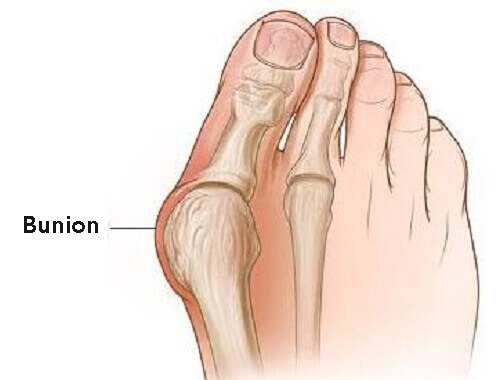Over the years, it’s not uncommon for most women to develop bunions. For those of you who are fortunate enough to have avoided them, bunions are found on the joint at the base of your big toe. It’s a large bump that protrudes out, and is the cause of a misalignment of the big toe joint.
A specific cause for bunions is unknown, but experts think genetics are to blame for some of the irregular foot function. Though uncomfortable footwear is believed by many to be the cause, there isn’t any factual proof to prove this is true. However, uncomfortable footwear could be a contributing factor along with a genetic disorder, trauma, or another additional cause.
Bunion symptoms vary – and in some cases may not cause any pain at all! However, most commonly they cause foot pain and, in severe cases, can cause arthritis. Some bunions require surgery if they are causing chronic pain, but there are a number of home cures for bunions before considering an operation.
Note: If you have bunions, you should consult with your doctor on the following suggestions.
1. Wear comfortable footwear
Though this alone won’t “cure” bunions, it will help to prevent further discomfort. You should have a comfortable pair of shoes that aren’t tight-fitting to your foot. Have a store associate measure your foot, and explain to them that you need a shoe that will not cause further discomfort.
If you’re shopping at The Shoe Spa for comfortable designer shoes, speak with a member of our team and explain that you need a loose-fitting shoe. Our staff knows our shoe brands and collections inside and out and can find you the perfect, comfortable shoe!
2. Use a mole-skin or gel-pad to cushion your foot
In addition to a comfortable pair of shoes, padding the bunions with moleskin of a gel-pad will prevent further discomfort and inflammation.
Bumping, rubbing, or other irritations to the area around the bunion can cause further damage to your toe and foot. Preventing these irritations can cause a bunion to recede over time and you won’t have to have an invasive surgery. Combine comfortable footwear and padding with an anti-inflammatory medicine, such as Ibuprophen or Aleve, for better results.
3. Olive Oil & an Icepack
Massage the affected area with warm olive oil. In a circular motion, gentle massage your toes and lower foot with the olive oil for fifteen minutes, several times a day.
Some say that the massage relieves pain and inflammation by increasing blood circulation to the area. Afterwards, place an ice pack on the area for ten minutes to further reduce swelling.
4. Sliced soap and Iodine
Amazingly, plain soap can alleviate pain and inflammation from bunions. Use soap slices to massage the area of your foot.
Create a cross-cross pattern with iodine over the bunions for the best absorption. Once it dries, put warm socks on immediately. This treatment can be used for 30 days.
5. Epsom salt bath
Like all other bodily soreness, the pain and inflammation of bunions can be relieved with a warm bath and Epsom salts.
Either draw a hot bath or use a small tub and hot water to soak your feet. Dissolve the Epsom salt in the water and soak for 20 minutes. You should soak your feet two times a day to decrease the size of the bunions.
